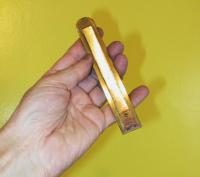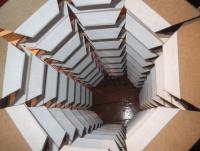-
Posts
558 -
Joined
-
Last visited
Everything posted by Mike Pierceall
-
This is a 32' reed from one of my harmonium restorations. It speaks as quickly as the smallest reed in the organ. Large reeds need to be sturdy due to the force required to lift them. I once restored an organ where 7 of the sub-bass reeds were broken off at the heel and the tongues had been sucked into the air reservoir.
-
Individual cards, gussets, hinges, and papers; jigs and assembly procedures. It's here:
-
Unless the private party is a known member of the concertina community, or can be vouched for by someone in the community, I won't do it as a rule, though I made an exception once. That's when the buyer had a friend in my area, who acted as the buyer's agent. Everything was pre-arranged and the concertina was sold "as-is."
-
Right. I've used chip board before and it is very stiff stuff, more so than cotton rag board. I'm really trying to make the bellows as trim and proper as possible as were the originals. My Aeola has the original 5-fold set from 1909, and they are the exemplar. Using reed organ reeds is problematic for several reasons, but they are often parted out from un-restorable instruments so finding a few sets wouldn't be difficult, though getting them to work in a concertina may be impossible though that's never stopped me from trying before.
-
Full disclosure here, Geoff. I'm experimenting with jigs and other building schemes and materials so this set of bellows is not specifically intended for any instrument. For the cards here I am using architectural chip board, which is thinner than the rag board I've used before. It is a recycled pulp product. The inner hinges are gummed linen, available here from a photo supply house. The idea is to construct a set of bellows with extra folds, yet one that compresses down to a final dimension comparable to a standard set. I'm considering the idea of building a concertina, using reed organ reeds, so I may utilize this set of bellows for that.
-
-
A video of a sample set of bellows cards and the method utilized. It's here:
-
I'd suggest you purchase a copy of David Elliott's Concertina Maintenance Manual and perhaps pass the Rochelle on to someone who can benefit from it as you did.
-

English Verses Maccann Duet?
Mike Pierceall replied to Tarquin Biscuitbox's topic in General Concertina Discussion
I wish more people felt the way you do about the English, my choice, as it would lessen the competition to acquire another. Alas, my experience is just the opposite, both for the former and the latter. -

Aeola Bellows Construction
Mike Pierceall replied to Mike Pierceall's topic in Instrument Construction & Repair
My previous video is of a set I made using Robert Tedrow's method. I decided to cut the cards individually on this set; however. There are advantages to each method, but the results are the same. With a properly made bellows form, keeping the corners aligned wasn't difficult. The difference between the two methods is largely a matter of time as each card has to be individually cut and hinged to it's mate with the standard method. On the other hand, with the Tedrow method, hinging the long strips of card causes the strips to bow, and that has to be controlled with lots of clamps. Cutting the long, gathered blank of cards requires great care, especially since I don't own a band saw and used a table saw - a risky procedure I do not recommend. -
Construction video on the making of an 8-sided bellows for a treble Aeola. It's here:
-

Installing Gussets Video
Mike Pierceall replied to Mike Pierceall's topic in Instrument Construction & Repair
I say that if what you are using is working, then stick with it One of the reasons that builders and restorers use hide glues is they can be reactivated with heat and/or moisture, which makes repair or replacement far easier. -

Installing Gussets Video
Mike Pierceall replied to Mike Pierceall's topic in Instrument Construction & Repair
Hi, David. Fish glue has a shear strength of 3200 psi. I only use it for glue-on applications like gluing leather or fabric to card stock or wood, but never for wood-on-wood applications. It is used in the pipe organ trade for building pneumatic components. I've tried removing it by wetting the materials, but it would need to be soaking wet for a period of time. I tend to think that if someone's concertina is soaking wet, there is a bigger problem than the glue Mike -

Installing Gussets Video
Mike Pierceall replied to Mike Pierceall's topic in Instrument Construction & Repair
I've used both methods, but the way I did it in the video is similar to builders like A.P. James. After the glue has dried, I use scissors to clip the "ears" from the corners and then feather, or skive, the leather with a razor blade to produce a smooth corner. I do not skive the edges of the gussets. I use thin, soft leather; fish glue, which remains pliable for a time; and I use a nipping press to compress the bellows to "iron out" the transitions. I use a textured bellows paper, which also helps to produce a pretty-looking set of bellows. -
On this Aeola Bellows here:
-

Bellows Making Video
Mike Pierceall replied to Mike Pierceall's topic in Instrument Construction & Repair
You mean other than elation? ...you would need to modify either the geometry of the bellows to fit the new instrument... or vice versa? I've been lucky in that I've never had to replace the bellows in the Aeolas or the one Edeophone I've owned. I wonder if they are inherently more durable. -

Bellows Making Video
Mike Pierceall replied to Mike Pierceall's topic in Instrument Construction & Repair
You mean other than elation? -
I've just finished making a spare set of bellows for the next instrument that (hopefully) finds its way to my doorstep. Here is the video I made of the process along with some background music I've recorded over the years. It's here:
-

What's The Benefit Of A 7-Fold Bellows?
Mike Pierceall replied to Halifax's topic in Instrument Construction & Repair
Perhaps it would be more illustrative to compare the video you reference against another I made of the same instrument with the original bellows here: -

What's The Benefit Of A 7-Fold Bellows?
Mike Pierceall replied to Halifax's topic in Instrument Construction & Repair
Ok, let's agree then that larger reeds consume a greater air flow but the pressure conditions are the same for small and large reeds while playing. The on-set by larger reeds however may be slower. Concerning folds again...mostly the difference between 6 or 7 has very little practical significance but of course mainly depending on the music ...if playing single notes 4 folds ( common among Victorian englishes) may be quite sufficient even with an anglo but you hardly find less than 5...if playing multi note harmonies with an anglo you may rather need 10 than 7. It is a matter of cost, production set-up, and tradition. The results from depth of folds are complex. If construction is exactly the same otherwise deeper folds are expected to result in less stability ( greater flexibility if that is wanted...) and less volume but it depends on how extractable the construction is. I guess that when you said: " I gained about 3 inches of travel without adding any additional folds". you meant that you could extract the bellows 3" more. Or? If so...are you sure that the total volume was any larger at all? and when you play with the bellows continuosly rather closed, the volume resource likely is smaller with the extra deep folds, meaning that you will have to do more frequent bellows reversals. Or? Have you measured it? I'm still confused regarding this : "deeper folds...helps compensate for the extra force required to operate larger volume instruments". My experience is rather that a wide bellows with shallow folds usually becomes more stable and that helps operate larger volume instruments...seemingly the opposite...but maybe I misunderstood what you said... That's an interesting insight. I found that, in practice, deeper folds exert more leverage, allow longer passages, can be made in a way that allows stability, e.g., not adding additional folds, and reduce the number of bellows reversals during play. It's a bit like the violinist using the bow to the fullest extent. This is my experience as an English player. -

What's The Benefit Of A 7-Fold Bellows?
Mike Pierceall replied to Halifax's topic in Instrument Construction & Repair
Sorry but I don't see what you mean: "Larger volume instruments produce less pressure for a given amount of force," If the volume is larger since the bellows is longer (more folds) the pressure/force relation is the same. If the volume is larger since the end area is larger you do get less pressure for a given amount of force. Right? " the larger scale reeds in general require more pressure". What has larger scale reeds with it to do? If you play a high note and a low note ( larger reed) simultaneously the "pressure" is the same, is it not? The air flow however is larger through the larger reed. " I gained about 3 inches of travel without adding any additional folds". Can you explain that more? What travel? And this still remains a riddle: " they tend to be looser in feel, which helps compensate for the extra force required to operate larger volume instruments". How does the flexibility (being "looser"..) compensate for the extra force? Wim Wakker writes about this much more eloquently than I in his section on "Reeds" and air pressure. Getting back to the original post, the advantage of additional folds is additional time - time to play a phrase or a chord. -

What's The Benefit Of A 7-Fold Bellows?
Mike Pierceall replied to Halifax's topic in Instrument Construction & Repair
Can you explain that more...I agree that the deeper folds makes the bellows "looser" , or at least more flexible, but in what way do you mean it " helps compensate for the extra force required to operate larger volume instruments." ? A "large" ( diameter) instrument needs extra force, yes. If the "volume" is larger only due to a longer bellows ( one with more folds) the stability is less ( if constructed the same way except from number of folds). You don't need extra force for pumping but you will waste more effort on stabilizing it. I would assume then that a wide AND long bellows (one with "larger volume"...) would be easier to handle with more shallow folds...?? A bellows with small diameter, but very long, would become fairly hopeless to manage if having deep folds...or? Larger volume instruments produce less pressure for a given amount of force, yet the larger scale reeds in general require more pressure. They tend to be slower to speak. Stability can definitely be compromised by deeper folds, though the set of deep-fold bellows I made for the Lachenal TT are not a problem. I gained about 3 inches of travel without adding any additional folds. -

What's The Benefit Of A 7-Fold Bellows?
Mike Pierceall replied to Halifax's topic in Instrument Construction & Repair
7 I think is very unusual with englishes and the difference between 6 and 7 just marginal. If you really need more volume with an english it may be a matter 10 rather than 7.... 7 is not unusual with anglos and the difference between 5 and 7 may be significant but in real the "difference" between 6 and 7 it may just as well be a matter of makes and models. Comparing exactly the same model with 6 or 7 may have some, but mostly very little, importance as well I think. The efficiency is depending on so much else. The extra folds help compensate for the drain that large reeds can have on bigger instruments but not necessarily to add more than a few seconds of sustain. In the case of the bellows I made for my Lachenal TT, I also made the folds an extra 3/8 inch deeper. Deeper bellows' folds exert more leverage at the hinge points, thus they tend to be looser in feel, which helps compensate for the extra force required to operate larger volume instruments. -

What's The Benefit Of A 7-Fold Bellows?
Mike Pierceall replied to Halifax's topic in Instrument Construction & Repair
Fewer bellows reversals on an English. Usually found on instruments with extended lower range reeds.




